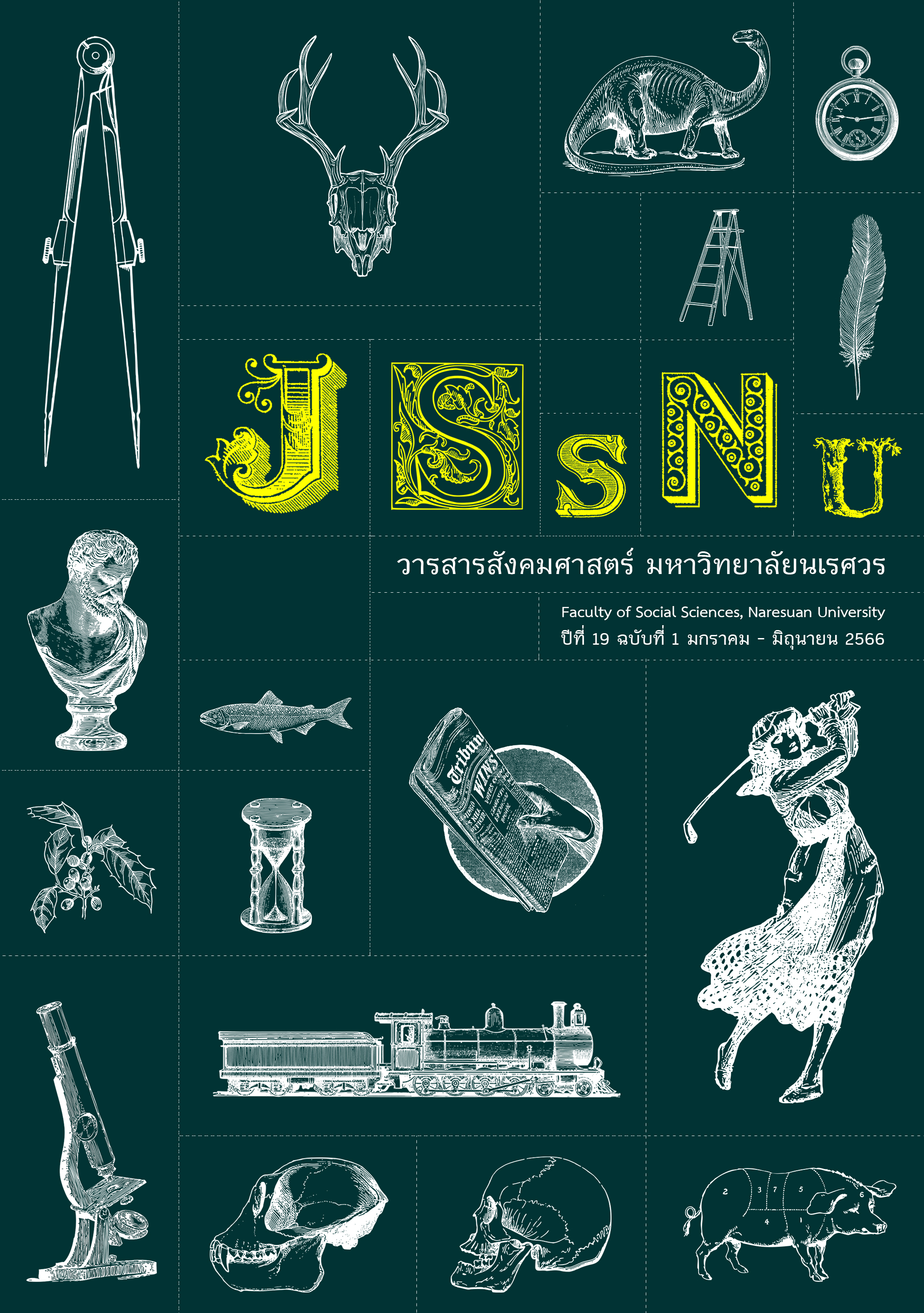Emergence of Islamic moral sentiment of the Indonesian Muslims, 1973-1988
Main Article Content
Abstract
This research paper aims to explore the role of emotions the Indonesian Muslim in the Indonesian politics between 1973 and 1988, in order to illustrate the emergence of collective religious sentiments among the Indonesian Muslims during this period. According to the research of the Indonesian Muslims emotions from the primary evidence, such as Indonesian poetries that were published from the 1970s to the late 1980s, as well as secondary sources of contemporary Indonesian historical and political writings since the early 1970s, the evident that shows the exclusion from national politics and the wave of Islamic revival had allowed Indonesian Muslims and political Islamic factions to rediscover and generate a new form of political and cultural spheres in which the Islamic moral sentiment was a crucial core that was still effective in the second decade of the twenty-fisrt century.
Downloads
Article Details

This work is licensed under a Creative Commons Attribution-NonCommercial-NoDerivatives 4.0 International License.
References
Abdullah, T. (1971). Schools and politics: The Kaum Muda movement in West Sumatra (1927-1933). Ithaca, NY: Cornell Modern Indonesia Project, Cornell University.
Anderson, B. (1972). Java in time of revolution: Occupation and resistance, 1944-1946. Ithaca, NY: Cornell University Press.
Anderson, B., & McVey, R. (2009). A preliminary analysis of the October 1, 1965, Coup in Indonesia. Singapore: Equinox Publishing.
Aveling, H. (Ed.). (2001). Secrets need words: Indonesian poetry, 1966-1998. Athens, Ohio: Ohio University Center for International Studies.
Azra, A. (2003). The Indonesian Marriage Law of 1974: An institutionalization of the Shari’a for social changes. In A. Salim & A. Azra (Eds.), Shari’a for social changes Shari’a and politics in modern Indonesia (pp. 76-95). Singapore: ISEAS–Yusof Ishak Institute.
Bateson, G., & Mead, M. (1942). Balinese character: A photographic analysis. NY: The New York Academy of Sciences.
Belo, J. (1935). Balinese temper. In D. G. Harings (Ed.), Personal character and cultural milieu (pp.120-146). Syracuse, NY: Syracuse University Press.
Belo, J. (1960). Bali trance. NY: Columbia University Press.
Bourchier, D., & Hadiz, V. R. (2003). Indonesian politics and society: A reader. London & NY: Routledge Curzon.
Brown, C. (2003). A short history of Indonesia: The unlikely nation? NSW, Australia: Allen & Unwin.
Cammack, M., Young, L. A., & Heaton, T. (1996). Legislating social change in an Islamic society-Indonesia’s marriage Law. The American Journal of Comparative Law, 44(1), 45-73.
Feith, H., & Castles, L. (Eds.). (1970). Indonesia political thinking, 1945-1965. Ithaca & London: Cornell university Press.
Geertz, C. (1960). The religion of Java. Glencore, Illinois: Free Press.
Geertz, C. (1973). The interpretation of cultures: Selected essays. New York: Basic Books
Geertz, H. (1961). The Javanese family: A study of kinship and socialization. New York: The Free Press of Glencoe.
Hamka [Pseudonym]. (1952). Perkembangan Tasauf dari abad ke abad. Djakarta: Penerbit Pustaka Keluarga.
Hamka. [Pseudonym]. (1981). Tasauf modern. Jakarta: Yayasan Nurul Islam.
Hefner, R. W. (2000). Civil Islam: Muslims and democratization in Indonesia. Princeton, NJ: Princeton University Press.
Heider, K. G. (1991). Landscape of emotion: Mapping three cultures of emotion in Indonesia. NY: Cambridge University Press.
Hindley, D. (1968). Indonesian politics 1965-7: The September 30 movement and the fall of Sukarno. The World Today, 24(8), 345-356.
Hollan, D., & Wellenkamp, J. (1994). Contentment and suffering: Culture and experience in Toraja. NY: Columbia University Press.
Hollan, D., & Wellenkamp, J. (1996). The thread of life: Toraja reflections on the life cycle. Honolulu: University of Hawaii Press.
Howell, J. D. (2001). Sufism and the Indonesian Islamic revival source. Asian Studies, 60(3), 701-729.
Kahin, G. M. (1952). Nationalism and revolution in Indonesia. Ithaca, NY: Cornell University Press.
Nagata, J. (1980). Religious ideology and social change: The Islamic revival in Malaysia. Pacific Affairs, 53(3), 405-439.
Naipaul, V. S. (1982). Among the believers: An Islamic journey. NY: Vintage Books.
Palmier, L. H. (1954). Modern Islam in Indonesia: The Muhammadiyah after independence. Pacific Affairs, 27(3). 255-263.
Puaksom, D. (2017). The Javanese subaltern hero: Muslim states, council of saints, and the earthworm sage. Bangkok: Gypzy Group. [in Thai].
Raillon, F. (1993). The new order and Islam, or the iImbroglio of faith and politics. Indonesia, 57, 197-217.
Reddy, W. M. (2001). The navigation of feelings: A framework for the history of emotions. NY: Cambridge University Press.
Ricklefs, M. C. (2001). A history of modern Indonesia since C. 1200 (3rd ed). Basingstoke: Palgrave.
Ricklefs, M. C. (2006). Mystic synthesis in Java: A history of Islamisation from the fourteenth to the early nineteenth centuries. Norwalk, CT: EastbBridge.
Ricklefs, M. C. (2007). Polarising Javanese society: Islamic and other visions c.1830–1930. Leiden: KITLV Press.
Ricklefs, M. C. (2012). Islamisation and Its opponents in Java: A political, social, cultural and religious history, c. 1930 to present. Singapore: NUS Press.
Schrieke, B. (1957). Indonesian sociological studies-selected writings of B. Schrieke, part two: Ruler and realm in early Java. Hague: W. van Hoeve.
Shiraishi, T. (1990). An age in motion: Popular radicalism in Java, 1912-1926. Ithaca, NY: Cornell University Press.
Slater, D. (2010). Ordering power: Contentious politics and authoritarian leviathans in Southeast Asia. Cambridge: Cambridge University Press.
Thee Kian Wie. (2002). The Soeharto era and after: Stability, development and crisis, 1966–2000. In H. Dick, V. J. H. Houben, J. T. Lindblad, & T. K. Wie (Eds.), Emergence of a national economy: An economic history of Indonesia, 1800-2000 (pp. 194-243). NSW, Australia & Honolulu, Hawaii: Allen & Uuwin and University of Hawaii Press.


